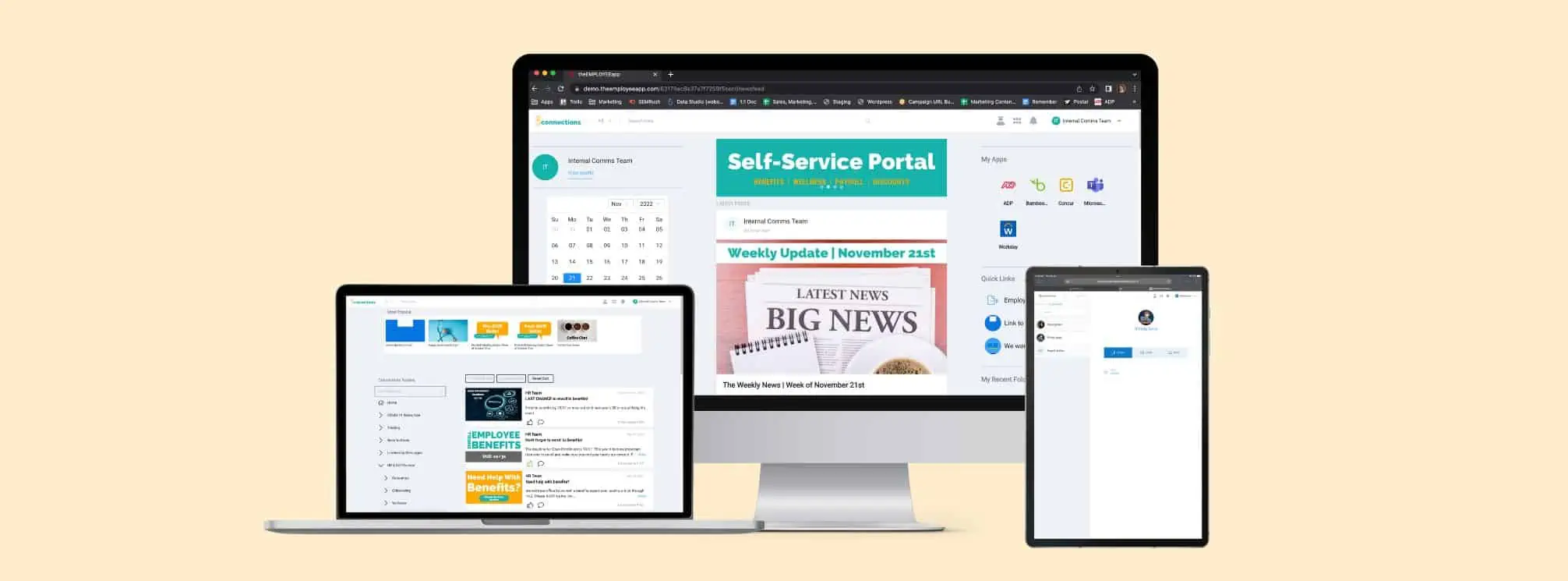Employee Experience Apps: Everything You Need to Know
In the modern workforce, employee experience is a key consideration. With EX impacting everything from retention to productivity and profit, more companies are turning to employee experience apps. Read this guide to learn everything you need to know about EX applications.
What Are Employee Experience Apps?
Before we can talk about DEX and how to evaluate technology solutions, let’s define this type of software.
Employee experience apps (also called workplace experience apps) are applications with the primary purpose of enabling employees to do their best work by removing barriers, connecting them with the right resources, and generally helping them be more efficient.
But that’s a large umbrella of applications, right? This can make picking the right EX app for your workforce challenging. In the rest of this article, we’ll break down what DEX is as well as considerations when selecting an employee experience application.
[optin-monster slug=”gtdhyl79d4vzutefmif9″ followrules=”true”]
What is Digital Employee Experience?
Because employee experience apps are yet another digital touch point for employees, we have to talk about digital employee experience (DEX).
If employee experience is what it’s like to work for your company, digital experience is what it’s like to use all the digital platforms a company uses. Many companies have an IT team to manage the digital tech stack of a company, but we know that departments and frontline teams sometimes go rogue and adopt their own platforms. But that still counts as a factor of their digital employee experience.
It’s up to companies to learn exactly what technology their teams are using, understand what their employees really need, and come up with the right combination of technology. Too often, we have multiple, individual tools and services to get our work done. But this leads to a cluttering of tech. The list of passwords adds up. Some tools go unused because they haven’t been properly introduced. The list of challenges goes on, and this leads to an overwhelming digital workplace experience.
How Do You Create a Simple Digital Experience?
So, how do you simplify that digital experience? We have a few suggestions that internal comms, human resources, and IT teams can all contribute towards:
- Conduct an audit of all employee-facing systems. This includes auditing your internal communications channels as well as any HR or operations tool. Determine what each tool is used for, its level of importance, and how all those technologies work together. It’s possible there are other HR or internal comms channel providers that might help you simplify and consolidate.
- Create employee personas and empathy maps. To truly create a simple employee experience, you have to understand your audience. What are their challenges with your current technology and in their roles? And how can updating your tech stack help solve those challenges?
- Improve your change management process. One reason digital experiences become overwhelming is a lack of proper training, a hasty rollout, or lack of follow up and reinforcement. All of these issues can be solved by improving your change management communication.
[optin-monster slug=”nr28vapfqhv3y1kla2yr” followrules=”true”]
What Are the Best Employee Experience Apps?
Defining the best employee experience apps is difficult to do because there are such a wide variety of tools. And even more challenging is that so few of them are just for EX. Often, these tools are really geared towards something more specific.
For example, Officevibe is a great solution, but it’s geared towards office workers and employee recognition. It is great for consolidating employee goals and performance into one place, while also allowing the company to send regularly cadenced pulse surveys to collect feedback. It’s actually a great platform, but it only accounts for a small part of the employee experience.
And then there are internal communication solutions as well, like theEMPLOYEEapp, that often consider EX, but are ultimately geared towards improving communication.
So, it’s likely that there isn’t one single solution that will be best for improving EX at your company. That’s why it’s so important to define your goals, understand your audience, and consider your entire tech stack. You may need to replace certain tools or find partners that consolidate tools and channels.
For instance, theEMPLOYEEapp is both a mobile app for employees and an employee intranet. This helps cut down on the number of passwords an employee needs to remember but it also cuts down on clutter for the administrators of the platforms. If the internal comms team doesn’t need to manage multiple tools, that improves their employee experience as well.
How Can I Evaluate EX App Vendors?
Choosing the right app for employee experience doesn’t have to be overwhelming. Before meeting with potential partners, make sure you have the following:
- Goals for cleaning up your digital workplace experience.
- A framework of your existing tools and solutions.
- Data on the state of employee experience at your company.
This pre-work will give you some helpful context when talking to vendors to ensure you are truly selecting a technology partner who solves your challenges. When you demo different employee experience solutions, ask these questions:
- What is the login flow like for employees? Do you have single-sign-on (SSO) to simplify the login process?
- How can this technology save my employees time? Specific questions might include: Is there robust search functionality? Can we target content to cut down on comms overload? How are resources organized?
- Does this app integrate with our other tools and systems?
Depending on your organization and its needs, you likely will have other specific questions as well. But these three will help get you started and will be a good test of if the app provider considers employee experience in their development.
Why Choose theEMPLOYEEapp?
If improving employee experience is one of your company’s priorities, theEMPLOYEEapp is a great choice of communications app. We are hyper-focused on the needs and experience of your end-users and have developed our product specifically to solve the challenges for deskless and remote workers as well as the companies trying to reach them.
Here’s how you can use our solution to improve EX:
- Share regular recognition with employees. There are countless ways that you can recognize your teams with our application.
- Increase transparency. Many of our clients use our application to give executive leadership a better channel for reaching all their employees.
- Consolidate resources. We have an easily searchable folder structure within our app that makes it much easier and faster for employees to find the information they need to do their jobs.
- Connect employees to the right people. Our Directory function allows you to set up key department contacts (e.g. IT helpdesk, HR support) as well as individual contacts (e.g. regional managers) to make it easier for employees to get in touch with the right people.
Employee Experience App Success Stories
If you’re still not convinced that you need an app to help improve the flow of communication and the experience for your employees, read these case studies where companies have leveraged technology to make huge improvements for their employees.
- ELLWOOD knew that employees didn’t have sufficient access to information since phones weren’t allowed on the shop floor. They invested in an EX app so they could give employees access to information on break or at home.
- Margaret Mary health wanted more modern and streamlined tools for their employees so they would have an easier time finding information and connecting with their colleagues.
- KR Wolfe used theEMPLOYEEapp to connect with their remote technicians who spend 300 days on the road every year. The app helped to extend their culture but also give employees the ability to connect with other people who had been in that area before to make their visit more pleasant.
[optin-monster slug=”ucyxtz2fxemh6aryl4gg” followrules=”true”]



